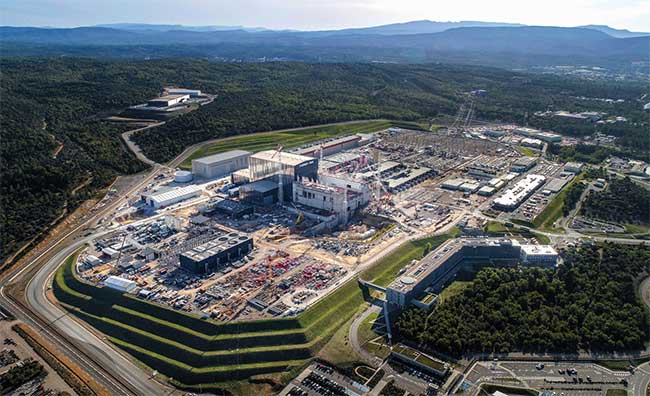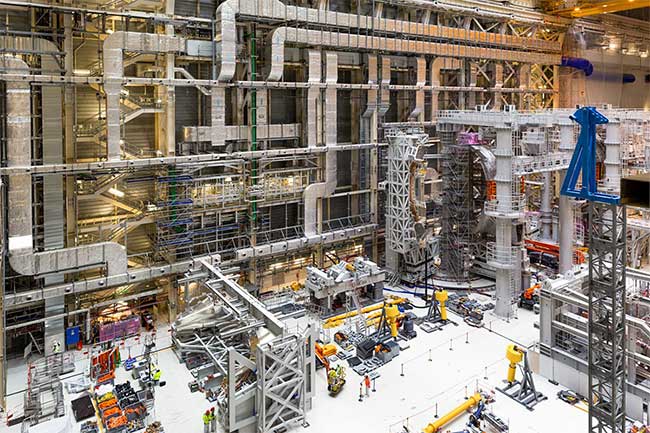This 1,000-ton magnet is the “heart” of the International Thermonuclear Experimental Reactor (ITER).
Clean Energy for Humanity: A Thousand-Year Solution?
By generating light and heat through nuclear fusion, the Sun has sustained life on Earth for billions of years. With such incredible power and longevity, it seems difficult to find a better way to generate energy by harnessing similar nuclear processes that occur in stars, including our Sun.
However, humans are aspiring to create an artificial nuclear fusion reactor right here on Earth: a machine that replicates the thermonuclear power of the Sun; one of the most ambitious energy projects ever attempted by humanity, aimed at generating a clean energy source for thousands, even millions, of years.
In southern France, 35 countries are collaborating to build the largest tokamak in the world, a magnetic fusion device designed to demonstrate the feasibility of fusion on our planet.
Located on a 180-hectare site in Saint-Paul-lès-Durance, southern France, a facility called the Tokamak Complex is under construction, adhering to an extremely ambitious experiment: a donut-shaped vacuum chamber surrounded by 1,000 tons of superconducting magnets capable of generating a magnetic field to initiate, confine, shape, and control the ITER plasma.

The 180-hectare Tokamak Complex under construction in Saint-Paul-lès-Durance, southern France. (Photo: Nuclear Newswire)
This 1,000-ton magnet has been manufactured with millimeter precision by a multinational corporation striving to harness nuclear fusion—the energy source of the stars!
Experts refer to it as the International Thermonuclear Experimental Reactor (ITER).
ITER is the largest nuclear fusion experiment in the world. Its primary objective is to demonstrate that nuclear fusion is safe and commercially viable. If everything goes according to plan, humanity will harness a massive amount of energy sustainably without harming the planet.
Weighing 23,000 tons, ITER is considered one of the most complex machines ever created; it is scheduled to begin producing its first plasma in 2025 before becoming fully operational around 2035.
ITER, being constructed as a collaboration among 35 nations, including EU countries, aims to further consolidate the concept of fusion. ITER Members include China, the European Union (EU), India, Japan, South Korea, Russia, and the United States, pooling resources for this project.
As the leading member of ITER, the European Union (along with the United Kingdom and Switzerland) is funding 45% of the project’s costs. Each of the other members— the United States, China, Japan, Russia, India, and South Korea—is contributing 9% each.

Inside the Tokamak Complex in France. (Photo: ITER)
Theoretically, nuclear fusion is a dream for energy: abundant; without the risk of meltdown, or emitting planet-warming carbon gases, or long-lived radioactive waste.
Nuclear fusion reactors aim to fuse hydrogen atoms to create helium, releasing energy in the form of heat. Maintaining this on a large scale has the potential to provide a safe, clean, and nearly inexhaustible power supply.
For this reason, the reactor is called ITER, which in Latin means “the way”—the path towards future energy. It is designed to make hydrogen nuclei fuse into helium, which will heat the walls of the reactor. In future reactors, this heat can boil water to run steam turbines.
“The Heart of the ITER Tokamak”
However, operating a thermonuclear reactor is a “technical nightmare.”
Theoretically, ITER will use magnetic fields to trap a superheated plasma of deuterium and tritium—heavier isotopes of hydrogen—so that their nuclei can fuse to create helium and release energy. ITER’s specific goal is to demonstrate that a tokamak can produce ten times the energy required to create the plasma.
This means that ITER is designed to achieve high thermonuclear power. For every 50 MW of electricity fed into the tokamak through the plasma heating system, it will generate 500 MW of thermonuclear power over a period of 400 to 600 seconds.
Fusion will occur when the plasma reaches 150 million degrees Celsius—ten times hotter than the core of the Sun—releasing a vast amount of energy transmitted as heat.
The problem is that no tokamak has yet achieved “scientific breakeven,” meaning where the reactor’s plasma releases an amount of energy equivalent to what is used to heat that plasma [or where the reactor’s output power matches what is used to heat the plasma, as explained by National Geographic].
When ITER reaches full power, expected in the mid to late 2030s, it is projected to exceed the “scientific breakeven” by at least a factor of ten. The goal: to generate data to help engineers design power plants fueled by stellar energy.
This tenfold return is represented by Q ≥ 10 (the ratio of input heating power to output thermal power). The current record for thermonuclear output in a tokamak is Q = 0.67, held by the European JET facility located in Culham, UK, which produced 16 MW of thermonuclear heat for 24 MW of heating power in the 1990s.
ITER Tokamak will be the largest ever built, with a plasma radius (R) of 6.2 m and a plasma volume of 830 cubic meters. ITER’s massive plasma mass will allow it to produce a “burning plasma” for the first time, where most of the heat needed to sustain the fusion reaction is generated by alpha particles produced from the fusion process itself. Producing and controlling such a self-heating plasma has been the goal of fusion research for over 50 years.

Weighing 23,000 tons, ITER is considered one of the most complex machines ever created. (Source: National Geographic)
The Central Solenoid acts as the ‘backbone’ of the ITER system. The United States is responsible for 100% of the manufacturing of the central electromagnet. And the ‘heart’ of ITER is this 1,000-ton superconducting magnet.
The gigantic 1,000-ton magnet is dubbed the “strongest magnet in the world,” with a magnetic force strong enough to lift an aircraft carrier out of the water, according to ITER.org.
The Central Solenoid will consist of six separately manufactured modules, each containing superconducting niobium-tin wire wound together.
When fully assembled, the Central Solenoid will be five stories high, 4.2 meters wide, and weigh 1,000 tons. It will be the most powerful superconducting electromagnet ever built, becoming the ‘beating heart of ITER.’
According to General Atomics, the Central Solenoid magnet generates most of the magnetic flux change needed to initiate plasma, create plasma flow, and maintain this current during the burn time.
The 1,000-ton Central Solenoid magnet was manufactured by the American defense and energy company General Atomics and completed in 2021.
Soviet physicist Lev Artsimovich (1909 – 1973), known as the “father of the Tokamak,” once stated that a tokamak is generally an experimental machine designed to harness the energy of nuclear fusion. Inside a tokamak, the energy generated through the fusion of atoms is absorbed as heat in the vessel walls.
Similar to a conventional power plant, a thermonuclear power plant will use this heat to produce steam and then electricity via turbines and generators, as stated on ITER’s website.
It is hoped that in just a few years, humanity will witness the ITER Tokamak generating vast, clean, and sustainable energy, meeting the energy needs of both the present and the future.
Enormous Numbers (Source: ITER.org)100,000 km 100,000 km of niobium-tin superconducting wire (Nb3Sn) is used to create the toroidal Central Solenoid magnet of ITER. 100,000 km of superconducting wire has been manufactured by suppliers from the ITER project—China, Europe, Japan, South Korea, Russia, and the United States—starting production in 2009 and completing it in 2014. Over 400 tons of this multifilament wire have been produced for ITER at a rate of about 150 tons/year, a dramatic increase in global production capacity (estimated, before scaling up for ITER, to a maximum of only 15 tons/year). Stretching from end to end, the total Nb3Sn wire produced for ITER would wrap around the Earth at the equator twice at 150 million °C. Magnets with twice the thrust of a space shuttle The temperature at the surface of our Sun is 6,000°C, while at its core, it reaches 15 million°C. This temperature, combined with the density in the Sun’s core, creates the necessary conditions for nuclear fusion to occur. In the ITER Tokamak, temperatures will soar to 150 million°C—ten times that of the Sun’s core. 23,000 tons The ITER machine will weigh 23,000 tons. For comparison, the metal used in the Eiffel Tower weighs only 7,300 tons, making ITER three times heavier than the iconic structure. The vacuum vessel alone, along with its ports, covers, and divertor, weighs 8,000 tons. Around one million components will be integrated into this complex machine. 104 kmThe structure of the ITER Central Solenoid— a massive electromagnet weighing 1,000 tons at the center of the machine—is strong enough to contain a force twice that of the thrust produced by a space shuttle during launch. This amounts to 60 meganewtons, or over 6,000 tons of force. 310 tons Each of the 18 poloidal field coils of the ITER Tokamak will weigh 310 tons. These coils will be unloaded from ocean-going vessels before being transported along a specially modified route known as the ITER Journey on radio-controlled transport ships. 310 tons is approximately the weight of a fully loaded Boeing 747-300. Each poloidal field coil stands 17 meters tall and 9 meters wide. 400,000 tons About 400,000 tons will be situated on the foundation of the Tokamak Complex, which includes buildings, machinery, and the 23,000-ton ITER equipment. This 400,000 tons is more than the weight of the Empire State Building in New York, USA. 5,000 people The heaviest components of the ITER machine are transported to the nearest Mediterranean port and then moved along a 104 km specially modified route known as the ITER Journey. The size of these components is impressive: the heaviest will weigh nearly 900 tons, including the transport vehicle; the largest building will be about four stories tall. Some components will have a width of 9 meters, while others will be 33 meters long. According to National Geographic, ITER.org, Scitechdaily, Powerengineeringint, and Interestingengineering, at the peak of ITER’s construction from 2019 to 2022, around 5,000 people were involved at ITER (on-site and in offices), up from 1,400 in 2014. This increase is expected due to a significant rise in construction and assembly workers at the Tokamak Complex. 172,000 visitors The latest figures show that 172,169 people have visited the Tokamak Complex since work began in 2007 (which included land clearing and grading for future scientific installations). After a year of stagnation due to Covid-19, visitor numbers rebounded in 2021, reaching 11,540.
Leave a Reply |





















































